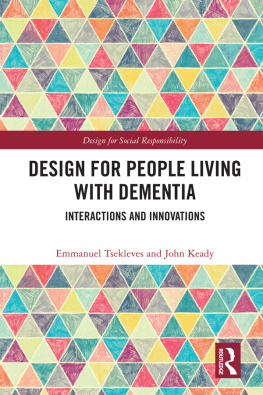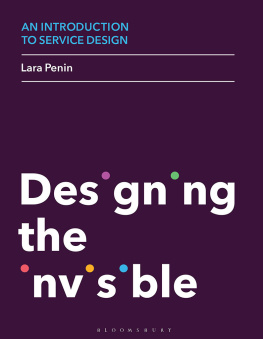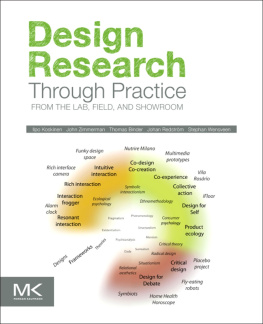DESIGN FOR CARE
INNOVATING HEALTHCARE EXPERIENCE
Peter H. Jones
 Rosenfeld Media Brooklyn, New York
Rosenfeld Media Brooklyn, New York
Design for Care: Innovating Healthcare Experience
By Peter H. Jones
Rosenfeld Media, LLC
457 Third Street, #4R
Brooklyn, New York
11215 USA
On the Web: www.rosenfeldmedia.com
Please send errors to:
Publisher: Louis Rosenfeld
Developmental Editor: JoAnn Simony
Interior Layout Tech: Danielle Foster
Cover Design: The Heads of State
Indexer: Nancy Guenther
Proofreader: Kathy Brock
Artwork Designer: James Caldwell, 418QE
2013 Peter H. Jones
All Rights Reserved
ISBN: 1-933820-23-3
ISBN-13: 978-1-933820-23-1
LCCN: 2012950698
Printed and bound in the United States of America
DEDICATION
To Patricia, my own favorite writer, who kept me healthy while writing for three years
To my mother, Betsy, whose courage and insight in her recent passing from a rare cancer gives me empathy for the personhood of every patient
And to my father, Hayward, whose perpetual resilience shines through after surviving two cancers and living life well
HOW TO USE THIS BOOK
Design for Care fuses design practice, systems thinking, and practical healthcare research to help designers create innovative and effective responses to emerging and unforeseen problems. It covers design practices and methods for innovation in patient-centered healthcare services.
Design for Care offers best and next practices, and industrial-strength methods from practicing designers and design researchers in the field. Case studies illustrate current health design projects from leading firms, services, and institutions. Design methods and their applications illustrate how design makes a difference in healthcare today. My hope is that you will adapt the lessons, methods, and insights in this book to a product, organization, or service system in your own work.
Who Should Read This Book?
Design for Care was written for three audiences: designers and design researchers in healthcare fields; healthcare professionals and clinical practice leaders; and service, product, and innovation managers in companies serving healthcare.
Healthcare is complex, and learning even one vertical slice of a vast field is a significant undertaking. Learning and working across a second sector is a career challenge. Working effectively across sectors is unheard of. Designers, researchers, and practitioners across all three audiences typically work within a single sectorfor a hospital, an information technology (IT) company, a medical products company, or a service provider. This book aims to inform design professionals across sectors (and design disciplines) and to contribute to their ability to design for the continuous life cycle of patient-centered service experiences. To ensure quality and manage costs across the whole system, a holistic view of healthcare and design is necessary.
For service designers, product, and innovation managers, I cover the most compelling information and service opportunities in healthcare with case studies and informed research. There are few guides for product managers in healthcare. Although this book does not specifically focus on product and project management, it weaves together many missing pieces overlooked in product and service innovation.
Most care providers work in one sector as well, deeply focused in a practice and an organization. This book helps inform clinical leaders of innovation methods, and encourages their understanding of the value of design thinking in health services, informatics, and organizational practice. Effective and ethical system design is not just making things work better for end users. Design leadership requires a collaboration at the practice level to contribute organizationally and systemically. I introduce health leaders to design and systems thinking approaches to help them innovate patient-centered service.
With the increased focus on improving the user experience in health websites and services, many designers new to the healthcare field will be learning about these users while on the job. Design for Care explores cases and methods for bettering human experience on both sides of the care experience, for both the patient and the care providers. It speaks to both new and experienced practitioners, and should be especially useful for those in transition between fields. For healthcare providers and those already managing projects inside the system, adaptation of successful methods and patterns is encouraged between different cases and uses.
Whats in This Book?
: Rethinking Care and Its Consumers
The three chapters in : Seeking Health examines personal health decision making.
: Rethinking Patients
The two chapters in : Patient-Centered Service Design presents a systems approach to service design, and attempts to resolve differing concepts found across health service approaches. Human-centered approaches to service design focus on the primacy of patient experience, improving the touchpoints of care along the continuum of service responsibility.
: Rethinking Care Systems
The four chapters in : Designing Healthcare Futures presents methods and models for reimagining healthcare service from near- and long-term future perspectives, to enable strategic and socially responsive innovation.
What Comes with This Book?
Youll find additional content in this books companion websites ( http://designforcare.com and  www.rosenfeldmedia.com/books/design-for-care/ ). Its diagrams and other illustrations are available under a Creative Commons license (when possible) for you to download and include in your own presentations. You can find these on Flickr at www.flickr.com/photos/rosenfeldmedia/sets/ .
www.rosenfeldmedia.com/books/design-for-care/ ). Its diagrams and other illustrations are available under a Creative Commons license (when possible) for you to download and include in your own presentations. You can find these on Flickr at www.flickr.com/photos/rosenfeldmedia/sets/ .
FREQUENTLY ASKED QUESTIONS
Who are the stakeholders for this book?
The book is written to ultimately help health seekersthe patients and people who seek information, health services, and care from todays fragmented healthcare systems. We all rely on healthcare at some point, for ourselves and those we care for; therefore, everyone can be a stakeholder.
We are the user experience and service designers in healthcare, care providers improving healthcare service, and product and project managers in health industries. We are the ones who will ultimately employ design in healthcare transformation. Other stakeholders include design and medical educators, management of hospitals and companies providing healthcare applications, and policy makers.
How do you resolve the different terminology used in different design disciplines?
Throughout the book, references are made to concepts and terms that have distinct meanings in their own fields. Because the book presents a convergence of design methods and human research across the sectors of healthcare, a collision of perspectives is to be expected. The design disciplines have variations in design practice, research methods, and artifacts that cannot be resolved in one book. Research and medicine are divided by discipline, method, and legacy.
The intention of this book is to raise crucial issues of which designers should be aware. The common bond among all these disciplines is the compelling requirement to solve complex problems in effective and sustainable ways. See .
















 Rosenfeld Media Brooklyn, New York
Rosenfeld Media Brooklyn, New York www.rosenfeldmedia.com/books/design-for-care/ ). Its diagrams and other illustrations are available under a Creative Commons license (when possible) for you to download and include in your own presentations. You can find these on Flickr at www.flickr.com/photos/rosenfeldmedia/sets/ .
www.rosenfeldmedia.com/books/design-for-care/ ). Its diagrams and other illustrations are available under a Creative Commons license (when possible) for you to download and include in your own presentations. You can find these on Flickr at www.flickr.com/photos/rosenfeldmedia/sets/ .